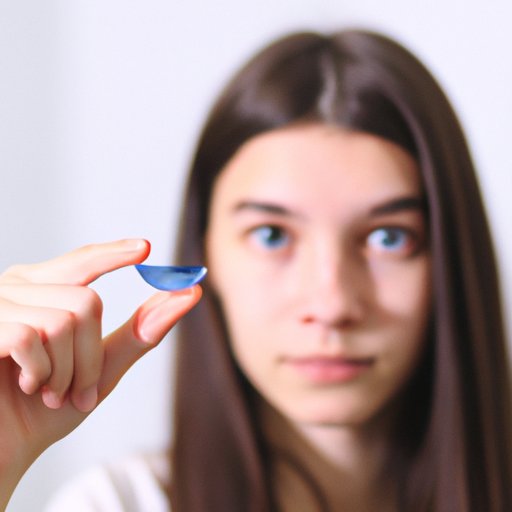
I. Introduction
Taking out contact lenses may seem like a simple task, but it’s important to do it properly and safely to avoid risks such as eye infections or scratches to the cornea. In this article, we’ll guide you through the process of removing both soft and rigid gas permeable (RGP) contact lenses, as well as troubleshoot common problems that may arise during the process.
II. Why Washing Your Hands is Important to Start
Before you start taking out your contacts, it’s important to wash your hands thoroughly to avoid transferring dirt or bacteria to your eyes. Unclean hands are one of the most common causes of eye infections for contact lens wearers. Use a mild soap and warm water, and dry your hands with a clean towel or air dryer.
When you have clean hands, try to avoid touching your face, particularly your eyes, to prevent transferring any oil or bacteria to your contacts or eyes.
III. Seeking Expert Help
If you’re new to wearing contact lenses, it’s a good idea to seek expert help before attempting to remove them yourself. Consulting an eye doctor or optician can help ensure that you’re properly handling the contacts and avoiding damage to your eyes. They can also provide you with a hands-on demo on how to remove the contacts safely and correctly
Even if you’re already experienced in removing contacts, if you’re experiencing difficulty or discomfort, don’t hesitate to seek professional help to avoid further problems.
IV. Essential Tools for Contact Removal
Having the right tools can make contact removal much easier and more comfortable. Before starting, ensure that you have proper lighting and a mirror to get a clear view of the contacts. It’s best to have a magnifying mirror to make sure that the contacts are properly positioned.
For soft contact lenses, the most common tools are fingers and suction cups. Opt for a soft suction cup to avoid damaging the lenses. Rigid gas-permeable contacts can be removed with fingers as well, though some additional tools like plungers may also be needed. Avoid using your nails to pinch or scoop the lenses out of your eyes, this may cause tears or scratches
V. Steps on Removing Soft Contact Lenses
To remove soft contact lenses, start by washing your hands and drying them with a clean towel. Look into the mirror and gently pull down your lower eyelid with one hand while using the other hand to slide the contact lens down onto the white part of your eye. Pinch the lens gently between your thumb and index finger and remove it. For the other contact, repeat the same process.
If the lens feels stuck, refrain from pulling or tugging it. Add a few drops of rewetting solution to your eye to help loosen the lens. If you still can’t remove the lens, seek help from an expert
Once both lenses are removed, place them in a lens case filled with fresh solution to help clean, disinfect, and store them.
VI. Steps on Removing Rigid Gas Permeable (RGP) Contact Lenses
To remove RGP lenses, wash your hands and dry them with a clean towel. Look upwards and pull down your lower eyelid using your middle finger. Gently slide the lens down to the lower part of your eye and pinch it with your index finger and thumb. Use your other hand to hold your upper eyelid up and look towards the floor. Move the lens down to the white of your eyes and gently pick it out taking care not to scratch your eyes.
It might take some time to get used to removing RGP contacts. Don’t get discouraged if you don’t succeed the first time. Keep practicing until you feel comfortable removing them
VII. Troubleshooting Problems Removing Contacts
Despite how easy it may seem, removing contacts is not always as straightforward as it seems. If you’re having trouble removing your contacts, try putting a few drops of rewetting solution on the contact. Wait for a few minutes before trying to remove the contact again. If the lens becomes stubborn or torn, don’t panic. Use a plunger to gently suction onto the lens and pull it out. Always avoid using your nails as this may create additional problems.
If you feel like the lens is stuck in your eye or your eyesight becomes unclear, contact your doctor immediately. Don’t try to remove the lens forcefully, as this can cause more damage to your eyes.
VIII. When to Seek Professional Help
If you are having problems removing your contact lenses or experiencing pain or discomfort when removing them, it is best to seek professional help. An eye doctor or optician can provide the help you need to remove them correctly. Neglecting proper removal techniques can have serious consequences to your eye health and put you at risk of developing eye infections or injuries.
IX. Conclusion
Removing your contact lenses properly and safely is essential to taking care of your eye health. Always wash your hands before starting the process and make sure to have the proper tools on hand to make the experience comfortable and easy. Remember to seek professional help when needed and avoid forcing the contact out of your eye. With a little practice, you’ll be able to remove your contacts with ease and avoid complications.
Don’t forget to take care of the lenses you remove with fresh solution before storing them as this helps keep them clean. Do the right thing for the optimal health of your eyes.




